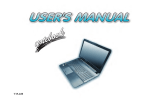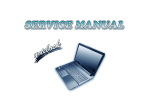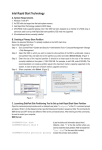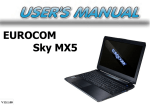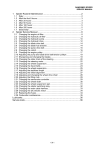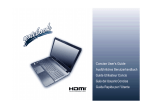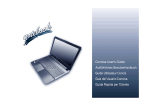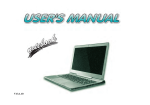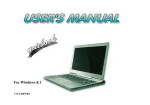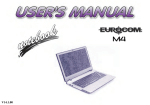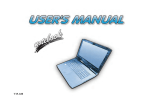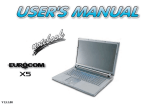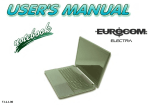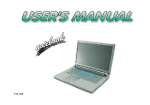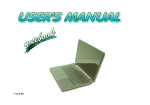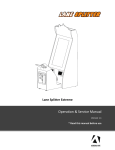Download Model B
Transcript
About this Concise User Guide Some or all of the computer’s features may already have been setup. If they aren’t, or you are planning to re-configure (or re-install) portions of the system, refer to the expanded User’s Manual. The Device Drivers & Utilities + User’s Manual disc does not contain an operating system. Regulatory and Safety Information Please pay careful attention to the full regulatory notices and safety information contained in the expanded User’s Manual on the Device Drivers & Utilities + User’s Manual disc. FCC Statement © December 2014 This device complies with Part 15 of the FCC Rules. Operation is subject to the following two conditions: Trademarks 1. This device may not cause harmful interference. 2. This device must accept any interference received, including interference that may cause undesired operation. Intel and Intel Core are trademarks/registered trademarks of Intel Corporation. 1 English This quick guide is a brief introduction to getting your system started. This is a supplement, and not a substitute for the expanded English language User’s Manual in Adobe Acrobat format on the Device Drivers & Utilities + User’s Manual disc supplied with your computer. This disc also contains the drivers and utilities necessary for the proper operation of the computer (Note: The company reserves the right to revise this publication or to change its contents without notice). English Instructions for Care and Operation The computer is quite rugged, but it can be damaged. To prevent this, follow these suggestions: • Don’t drop it, or expose it to shock. If the computer falls, the case and the components could be damaged. • Keep it dry, and don’t overheat it. Keep the computer and power supply away from any kind of heating element. This is an electrical appliance. If water or any other liquid gets into it, the computer could be badly damaged. • Avoid interference. Keep the computer away from high capacity transformers, electric motors, and other strong magnetic fields. These can hinder proper performance and damage your data. • Follow the proper working procedures for the computer. Shut the computer down properly and don’t forget to save your work. Remember to periodically save your data as data may be lost. • Note that in computer’s featuring a raised LCD electro-plated logo, the logo is covered by a protective adhesive. Due to general wear and tear, this adhesive may deteriorate over time and the exposed logo may develop sharp edges. Be careful when handling the computer in this case, and avoid touching the raised LCD electro-plated logo. Avoid placing any other items in the carrying bag which may rub against the top of the computer during transport. If any such wear and tear develops contact your service center. Power & Battery Safety • Only use an AC/DC adapter approved for use with this computer. • Use only the power cord and batteries indicated in this manual. • Your AC/DC adapter may be designed for international travel but it still requires a steady, uninterrupted power supply. If you are unsure of your local power specifications, consult your service representative or local power company. 2 • The AC/DC adapter may have either a 2-prong or a 3-prong grounded plug. The third prong is an important safety feature; do not defeat its purpose. If you do not have access to a compatible outlet, have a qualified electrician install one. • When you want to unplug the power cord, be sure to disconnect it by the plug head, not by its wire. • Make sure the socket and any extension cord(s) you use can support the total current load of all the connected devices. • Make sure that your computer is completely powered off before putting it into a travel bag (or any such container). • Only use batteries designed for this computer. The wrong battery type may explode, leak or damage the computer. • Do not continue to use a battery that has been dropped, or that appears damaged (e.g. bent or twisted) in any way. Even if the computer continues to work with a damaged battery in place, it may cause circuit damage, which may possibly result in fire. • Recharge the batteries using the computer’s system. Incorrect recharging may make the battery explode. • Do not try to repair a battery pack. Refer any battery pack repair or replacement to your service representative or qualified service personnel. • Keep children away from, and promptly dispose of a damaged battery. Always dispose of batteries carefully. Batteries may explode or leak if exposed to fire, or improperly handled or discarded. • Keep the battery away from metal appliances. • Affix tape to the battery contacts before disposing of the battery. • Do not dispose of batteries in a fire. They may explode. Check with local codes for possible special disposal instructions. • Do not touch the battery contacts with your hands or metal objects. Cleaning Note the following information which is specific to polymer batteries only, and where applicable, this overrides the general battery precaution information. • Use a soft clean cloth to clean the computer, but do not apply cleaner directly to the computer. • Do not use volatile (petroleum distillates) or abrasive cleaners on any part of the computer. • Before cleaning the computer remove the battery and make sure the computer is disconnected from any external power supplies, peripherals and cables (including telephone lines). • Polymer batteries may experience a slight expansion or swelling, however this is part of the battery’s safety mechanism and is not a cause for concern. • Use proper handling procedures when using polymer batteries. Do not use polymer batteries in high ambient temperature environments, and do not store unused batteries for extended periods. Battery Disposal & Caution The product that you have purchased contains a rechargeable battery. The battery is recyclable. At the end of its useful life, under various state and local laws, it may be illegal to dispose of this battery into the municipal waste stream. Check with your local solid waste officials for details in your area for recycling options or proper disposal. Danger of explosion if battery is incorrectly replaced. Replace only with the same or equivalent type recommended by the manufacturer. Discard used battery according to the manufacturer’s instructions. Servicing Attempting to service the computer yourself may violate your warranty and expose you and the computer to electric shock. Refer all servicing to qualified service personnel, particularly under any of the following conditions: • When the power cord or AC/DC adapter is damaged or frayed. • If the computer has been exposed to any liquids. • If the computer does not work normally when you follow the operating instructions. • If the computer has been dropped or damaged (do not touch the poisonous liquid if the LCD panel breaks). • If there is an unusual odor, heat or smoke coming from your computer. 3 English Polymer Battery Precautions System Startup English 1. 2. 3. 4. 5. 6. Remove all packing materials. Place the computer on a stable surface. Securely attach any peripherals you want to use with the computer (e.g. keyboard and mouse) to their ports. Attach the AC/DC adapter to the DC-In jack at the rear of the computer, then plug the AC power cord into an outlet, and connect the AC power cord to the AC/DC adapter (make sure you use the adapter when first setting up the computer, as to safeguard the computer during shipping the battery will be locked to not power the system until first connected to the AC/DC adapter). Use one hand to raise the lid/LCD to a comfortable viewing angle (do not to exceed 135 degrees); use the other hand (as illustrated in Figure 1) to support the base of the computer (Note: Never lift the computer by the lid/LCD). Press the power button to turn the computer “on”. 135° Figure 1 - Opening the Lid/ LCD/Computer with AC/DC Adapter Plugged-In System Software Your computer may already come with system software pre-installed. Where this is not the case, or where you are reconfiguring your computer for a different system, you will find this manual refers to Microsoft Windows 8.1. HDD RAID Support Your hard disk(s) can be set up in AHCI mode or RAID mode (for increased performance or protection). Note that setting up your hard disk(s) in RAID mode needs to be done prior to installing the Windows OS. Do not change the mode unless you intend to reinstall your operating system, and make sure you back up all necessary files and data before doing so. 4 Shut Down Note that you should always shut your computer down by choosing the Shut down command in Windows (see below). This will help prevent hard disk or system problems. Click the icon in the Start Screen and choose Shut down from the menu. Or at the bottom of the Start Right-click the Start button Screen or the Desktop and choose Shut down or sign out > Shut down from the context menu. Model Differences This notebook series includes two different model types that mainly differ as indicated in the table below. Model A Model B Design I Design II Design III Design IV Design V Design I Design II Display Type 15.6" (39.62cm), 16:9, QFHD (3840x2160)/WQHD+ (2880x1620)/FHD (1920x1080) 15.6" (39.62cm), 16:9, QFHD (3840x2160)/FHD (1920x1080) 15.6" (39.62cm), 16:9, QFHD (3840x2160)/ WQHD+ (2880x1620)/ FHD (1920x1080) NVIDIA® Discrete GPU NVIDIA® NVIDIA® GeForce GTX GeForce GTX 980M 970M NVIDIA® GeForce GTX 965M NVIDIA® NVIDIA® NVIDIA® GeForce GTX GeForce GTX GeForce GTX 980M 970M 970M Storage 17.3" (43.94cm), 16:9, FHD (1920x1080) NVIDIA® GeForce GTX 965M See Storage on page 39 for details. 3G/4G Module Factory Option No Sub Woofer No Yes Dimensions & Weight Design III See Dimensions & Weight on page 40 for details. Table 1 - Model Differences 5 English Feature RAID Setup English You may use your hard disks in combination with Striping (RAID 0), Mirroring (RAID 1) or Recovery for either fault tolerance or performance. RAID Level Description RAID 0 (at lease two hard disks/ SSDs needed) Identical drives reading and writing data in parallel to increase performance. RAID 0 implements a striped disk array and the data is broken into blocks and each block is written to a separate disk drive. RAID 1 (at lease two hard disks/ SSDs needed) Identical drives in a mirrored configuration used to protect data. Should a drive that is part of a mirrored array fail, the mirrored drive (which contains identical data) will handle all the data. When a new replacement drive is installed, data to the new drive is rebuilt from the mirrored drive to restore fault tolerance. Recovery (at lease two hard disks/ SSDs needed) Two Identical drives copying data between a master and a recovery disk. This provides more control over how data is copied between the master and recovery drives, fast volume updates and the ability to view the data in Windows Explorer. Table 2 - RAID Description • A hard disk installed in the Primary HDD bay and a second (identical) hard disk installed in the Secondary HDD bay. Or Two Identical solid state drives. • The Device Drivers & Utilities + User’s Manual disc. Note: All hard disks/SSDs in a RAID should be identical (the same size and brand) in order to prevent unexpected system behavior. RAID Setup Procedure 1. Start-up your notebook computer and press <F2> to enter the BIOS. 2. Go to the Boot menu, select UEFI Setting and press <Enter>. 3. Set UEFI Boot to “Enabled”. 4. Press <Esc> to exit the menu and go to the Advanced menu. 5. Select SATA Mode, press <Enter> and select “RAID Mode”. 6. Press <F4> and <Yes> to “Save Changes and Reset”. 7. After the computer restarts press <F2> to enter the BIOS again. 8. Go to Intel(R) Rapid Storage Technology (in the Advanced menu) and press <Enter>. 9. Select Create RAID Volume and press <Enter>. 10. You can now setup your RAID volume using any two installed disks. 11. Go to Name: and press <Enter>. 12. Type a name of your choice for your RAID volume and press <Enter>. Prepare the following before setting up your serial ATA hard disks in RAID mode: • The Microsoft Windows 8.1 OS disc. • An attached external DVD drive. 6 Figure 2 -Name the RAID Volume (Advanced > Intel(R) Rapid Storage Technology) 13. Go to RAID Level: and press <Enter>. 14. Choose the RAID Level required (see Table 2 on page 6) and press <Enter>. 21. The RAID volume will then be created and the RAID information will be displayed under Intel(R) Rapid Storage Technology (in the Advanced menu). • RAID 0 (Stripe)/RAID 1 (Mirror)/Recovery If you have selected a Recovery level RAID then you need to select one disk to be Master disk (M) and one disk to be the Recovery disk (R). Figure 3 Select Disks 17. You should select two identical disks to form your RAID volume. 18. If you have selected RAID 0 (Stripe) then you can adjust the “Strip Size” to your requirements. 19. If you have selected Recovery then you can adjust the Synchronization to “On Request” or “Continuous”. 20. Go to Create Volume and press <Enter>. Figure 4 RAID Information (Advanced > Intel(R) Rapid Storage Technology) 22. Press <Esc> to exit the menu. 23. Press <F4> and <Yes> to “Save Changes and Reset”. 24. Make sure the Windows 8.1 OS DVD is in the attached DVD drive and as the computer starts up it will automatically boot from the Windows 8.1 OS DVD (you will be prompted to press a key to boot from the DVD). 25. Press <F7> as the computer starts up to bring up the boot device menu. 26. Select the DVD drive containing the Windows 8.1 OS DVD and press <Enter>. 27. Press a key at system startup to begin installing Windows from your Windows 8.1 OS DVD. 28. Click Next > Install Now to continue installing the operating system as normal (see your Windows documentation if you need help on installing the Windows OS). 29. Follow the on-screen instructions to install the Windows 8.1 operating system. 30. Install the Windows drivers as per Table 5 on page 27. Make sure you install the Intel® Rapid Storage Technology (IRST) driver (see page 32). 7 English 15. Go to any of the disks listed under Select Disks: and select a disk name and press <Enter>. 16. Move the cursor down (use the arrow keys) onto X (or select the disk required) and press <Enter>. English System Map: Front View with LCD Panel Open (Models A & B) 3 2 1 33 3 2 1 3 4 Model A Model A 4 4 Model B Designs IV & V Designs I, II & III 15.6” (39.62cm) 15.6” (39.62cm) 6 3 2 1 3 6 6 5 5 7 Model B 6 17.3” (43.94cm) 6 6 5 7 7 5 8 8 9 8 5 9 9 Figure 5 - Front View with LCD Panel Open (Models A & B) 1. 2. 8 PC Camera *PC Camera LED *When the PC camera is in use, the LED will be illuminated. 3. 4. 5. 6. Built-In Array Microphone LCD Power Button Speakers 7. 8. 9. Keyboard Touchpad & Buttons Fingerprint Reader (Optional) LED Indicators The LED indicators on the computer display helpful information about the current status of the computer. Icon Color Description Off Integrated GPU (iGPU) in Use Green Discrete GPU (dGPU) in Use Green Scroll Lock Activated Green Caps Lock Activated Green Number Lock (Numeric Keypad) Activated Wireless Device Operation Aboard Aircraft Green Airplane Mode is ON (the WLAN, Bluetooth and 3G/4G Modules are OFF) Green The Hard Disk is in use Orange The Battery is Charging Green The Battery is Fully Charged Blinking Orange The Battery Has Reached Critically Low Power Status Orange The AC/DC Adapter is Plugged In Blinking Orange* The AC/DC adapter is plugged in and the powered USB Port is on* Green The Computer is On Blinking Green The Computer is in Sleep Mode The use of any portable electronic transmission devices aboard aircraft is usually prohibited. Make sure the wireless modules are OFF if you are using the computer aboard aircraft by putting the system in to Airplane Mode. Table 3 - LED Indicators 9 English *The powered USB 3.0 port (see page 17) may be toggled on /off by means of the Fn + Power Button key combination. When the powered USB port is on it will supply power (for charging devices only, not for operating devices) when the system is off but still powered by the AC/DC adapter plugged into a working outlet, or powered by the battery with a capacity level above 20% (this may not work with certain devices - see page 37). English Keyboard & Function Keys The keyboard includes a numeric keypad for easy numeric data input. Pressing NumLk turns on/off the numeric keypad. It also features function keys to allow you to change operational features instantly. The function keys (F1 F12 etc.) will act as hot keys when pressed while the Fn key is held down. In addition to the basic function key combinations, some visual indicators are available (in the Windows Desktop application only and not in the Start screen) when the hot key driver is installed. Keys Fn + Fn + Function/Visual Indicators Play/Pause (in Audio/Video Programs) Touchpad Toggle Turn LCD Backlight Off (Press a key to or use Touchpad to turn on) Fn + Mute Toggle Fn + Fn + Fn + Fn + PC Camera Power Toggle Windows Logo Key Figure 6 - Keyboard Keys Fn + Function/Visual Indicators Airplane Mode Toggle Sleep Toggle Number Lock Toggle Scroll Lock Toggle Caps Lock Toggle Fn + Power Button Change Display Configuration Brightness Decrease/ Increase Numeric Keypad Fn + Toggle Keyboard Illumination/Adjust Brightness Level Volume Decrease/ Increase Fn + Fn + Fn + Powered USB Port Power Toggle (see page 17) Control Center Toggle (see page 11) Fan Automatic Control/ Full Power Disable/Enable Flexikey® (see page 13) Table 4 - Function Keys & Visual Indicators 10 ScrLk & NumLk Fn Key Fn + Fn + Fn + Function Keys Power Modes The Control Center in Windows 8.1 works under the Desktop app and not under the Start screen. Press the Fn + Esc key combination, or double-click the icon in the notification area of the taskbar to toggle the Control Center on/off. The Control Center gives quick access to frequently used controls and enables you to quickly turn the camera/Touchpad on/off. You can set a Power Mode by clicking the appropriate icon at the top of the Control Center. Each power mode will affect the Power Conservation Mode, Airplane Mode, Power Plan and PC camera power etc. Figure 7 - Control Center Control Center Menus Power Status The Power Status icon will show whether you are currently powered by the battery, or by the AC/DC adapter plugged in to a working power outlet. The power status bar will show the current battery charge state. Brightness The Brightness icon will show the current screen brightness level. You can use the slider to adjust the screen brightness or the Fn + F8/F9 key combinations, or use the Fn + F2 key combination to turn off the LED backlight (press any key to turn it on again). Note that screen brightness is also effected by the Power Mode selected. The Control Center contains 3 menu headings (System Program, Device and Gaming) under the Power Modes. Click the Control Center icons to toggle the appropriate function, or hold the mouse button down and move the dial control where applicable. Certain functions will automatically be adjusted when a power mode is selected. Click the menu headings and then Volume click any of the buttons. The Volume icon will show the current volume level. You can use the slider to adjust the volume or the Fn + F5/F6 key combinations, or use the Fn + F3 key combination to mute the volume. 11 English Control Center English Power Conservation This system supports Energy Star power management features that place computers (CPU, hard drive, etc.) into a low-power sleep mode after a designated period of inactivity. Click either the Performance, Balanced or Energy Star button. Fan Speed The fan speed will adjust itself automatically to control the heat of the CPU. However you can adjust the setting to maximum if you prefer. Select Custom and click on the sliders to adjust the settings to your preference, however these settings can be overidden by the system, as a safety precaution, if it requires heavier use of the fan. above. The Display Utility allows you Left Windows Key to adjust text size on the screen to make it easier to view. Click Disable to disable the Windows Key on the left side of the keyboard. Display Switch This may be useful if you are using the Click the Display Switch button to ac- gaming keys (W, A, S & D) and wish cess the menu (or use the + P key to avoid accidentally triggering menus combination) and select the appropri- with the Windows Key. ate display mode. Headphone Time Zone The headphones may be set for differClicking the Time Zone button will ent effects using this menu. access the Date and Time Windows control panel. Backlight Keyboard Click the numbers under Desktop Background the Backlight Keyboard icon to adjust the brightness of the keyboard backlight LED. Clicking the Desktop Background button will allow you to change the Flexikey® desktop background picture. Sleep Button Click the button to access Click either the Hibernate or Sleep the Flexikey® application. Touchpad/PC Camera button to have the computer enter the Click either of these buttons to toggle selected power-saving mode. the Touchpad or camera module’s power status. Note that the power staDisplay Utility The Display Utility icon will only ap- tus of the camera module is also efpear in the System Program menu if fected by the Power Mode selected. your display’s resolution is QHD or 12 Profiles The Flexikey® application is a quick hotkey configuration application, which allows you to assign a single key to launch multiple key combinations, or to launch programs and applications, to create text macros and to disable certain keys. The application can also be used to configure the mouse buttons to create hotkeys for gaming etc. All the configuration settings are retained under (up to12) profiles to which the settings are applied. The menus on the left side of the application relate to Profiles. You can Add or Delete profiles (you can maintain 12 active Profiles), Export and Import profiles from the menus. If you double-click on a profile you can change the Profile Name, and change an Image file (images created using PNG files). Figure 8 Flexikey® Application The Flexikey® application can be accessed by clicking the button in the Gaming section of the Control Cenin the notification area of ter or by clicking the icon the desktop taskbar. Enabling or Disabling the Flexikey® Profile in Use You can enable or disable any keyboard or mouse profile functions currently in use by using the Fn + key combination. Pressing this key combination will toggle you between the currently selected keyboard or mouse profile to the standard keyboard and/or mouse settings, and back again. Windows Logo Key Keyboard and Mouse Settings Click Enable to create settings for the keyboard and/or mouse by clicking the button on the top left of the screen (e.g. you may wish to create a profile with settings only for the mouse or keyboard). Clicking on the keyboard or mouse icons will allow you to access the settings page for either the keyboard or mouse. and P key Note that you can assign actions to any keyboard key except the Windows Logo Key and P key. Figure 9 - Enable (Keyboard & Mouse) 13 English Flexikey® Application English Keyboard Settings The keyboard settings allow you to configure actions for any single key (or a combination of keys). Click the key and then select the Action Type (Express Key, Launch App, Express Text or Disable) from the menu at the bottom of the page. You can rename the action by clicking in the Name box, and click in Tool Tips to type in a note to remind you of the action’s function. by clicking in the Name box, and click in Tool Tips to type in a note to remind you of the action’s function. Figure 11 - Mouse Configuration Flexikey® Application Features: Figure 10 - Keyboard Configuration Mouse Settings The mouse settings allow you to configure actions for the left 1 , right 2 and middle 3 buttons of any attached mouse, and also for any backward 4 and forward 5 buttons if applicable (on a gaming type mouse). Click the button number and then select the Action Type (Express Key, Launch App, Express Text or Disable) from the menu at the bottom of the page. You can rename the action 14 • EXPRESS KEY - This feature allows you to configure a single key (or mouse click) to send multiple key combinations, or to create more useful shortcut keys This is useful in gaming or when using applications which have a complex set of keyboard shortcuts. • LAUNCH APP - This simply assigns single keys (or mouse clicks) to launch any program’s or application’s executable file. • EXPRESS TEXT - With this you can assign single keys (or mouse clicks) to send commonly used strings of text. • DISABLE - Use this function to disable any keyboard keys or mouse buttons. • STATISTICS - Use this to quickly record keys in use in any application, and to disable unused keys. Keyboard Settings - Express Key To configure a single key to send multiple key combinations, or to create more useful shortcut keys, use Express Key. 2. 3. 4. 5. 6. Enable and select the keyboard under your chosen profile, click on a key to select it, and then click to select Express Key in Action Type. In the following example we want to change an existing game key configuration which uses the left shift key for sprinting, and the W key for moving forwards, to use the left Ctrl key to combine this movement to sprint forward. Click on the chosen key for the shortcut action. Click in the Tool Tips field and type to give the key combination a name e.g. “Sprint Fwds”, then click back in the Name field (to avoid adding the recorded keys to the Tool Tips name). Click Start Record and then press the key or keys (in this case we will press Left Shift and W) required (make sure you press the key(s) required and do not click on them). Click Stop Record to complete the process. If you want to clear all the settings click Restore to return to the default key setting. 10. Any assigned Express Keys will appear in orange. Keyboard Settings - Launch App You can configure keys to launch any application or program as follows: 1. 2. Enable and select the keyboard under your chosen profile, click to select a key to launch the appllication, and then click to select Launch App in Action Type. Click Browse... at the bottom right of the application window. Figure 13 - Keyboard - Launch App 3. Figure 12 - Keyboard - Express Key 7. 8. Click Save to save the settings within your chosen profile. If you want to remove any individual key click to select it, and then click Delete. 4. 5. 6. Navigate to the executable file of the application and click Open. The key will now be configured to open the selected application under your chosen Profile, and the key will appear in green. If you want to remove any Launch App key, select it and click on Restore. Click Save to save the settings within your chosen profile. 15 English 1. 9. Keyboard Settings - Express Text Keyboard Settings - Disable A single key can be set to send a string of text within any application using Express Text. You can use the program to disable any keys not required. English 1. 2. 3. Enable and select the keyboard under your chosen profile, click to select a key, and then click to select Express Text in Action Type. Click in Start key if required (the Start key is the key used in your target program to open a text message), or you can leave it blank if you prefer. Click in the Click to type field and type in your message. Figure 14 - Keyboard - Express Text 4. 5. 6. 7. 16 Click in Send key if required (the Send key is the key used in your target program to send a text message e.g the Enter key would be the most commonly used), or you can leave it blank if you prefer. The key will now be configured to send the text message in the target program under your chosen Profile, and the key will appear in blue. If you want to remove any Express Text key, select it and click on Restore. Click Save to save the settings within your chosen profile. 1. 2. 3. 4. 5. Enable and select the keyboard under your chosen profile, click to select a key to disable, and then click to select Disable in Action Type. The key will now be disabled. If you want to enable the key again, select it and click on Restore. Click Save to save the settings within your chosen profile. The key will be disabled under your chosen Profile, and the key will appear in gray. System Map: Front, Left & Right Views (Model A ) 1 Front English USIM Card Ejection Simply press on the USIM card to eject it, however do not do this while a connection is in progress. Left 2 3 4 5 5 Right 6 7 9 8 10 11 11 12 13 Inserting Cards into the Card Reader 9 \ 10 Note that the cards should be inserted with the readable side of the card facing upwards, as illustrated on the right. Figure 15 - Front, Left & Right Views (Model A) 1. 2. 3. 4. 5. 6. LED Indicators Vent HDMI-Out Port *Powered USB 3.0 Port *Toggle power to this port by using Fn + power button (see Table 3 on page 9). Mini DisplayPorts S/PDIF-Out Jack 7. 8. 9. 10. Microphone Jack Headphone Jack Multi-in-1 Card Reader USIM Card Reader (for 3G/4G USIM Cards) 11. USB 3.0 Ports 12. RJ-45 LAN Jack 13. Security Lock Slot If you do eject the card while a 3G/4G connection is ongoing, you will need to shut down the system, reinsert the USIM card, restart the system and then reestablish the 3G/4G connection. If you wish to change USIM cards then you will also need to shut down the system, reinsert the USIM card, restart the system and then reestablish the 3G/4G connection. 17 System Map: Front, Left & Right Views (Model B) 1 English Front Left 2 3 4 5 5 Right 6 7 8 9 9 10 11 12 Inserting Cards into the Card Reader 10 Note that the cards should be inserted with the readable side of the card facing upwards, as illustrated on the right. Figure 16 - Front, Left & Right Views (Model B) 1. 2. 3. 4. 5. 18 LED Indicators Vent HDMI-Out Port *Powered USB 3.0 Port *Toggle power to this port by using Fn + power button (see Table 3 on page 9). Mini DisplayPorts 6. S/PDIF-Out Jack 7. Microphone Jack 8. Headphone Jack 9. USB 3.0 Ports 10. Multi-in-1 Card Reader 11. RJ-45 LAN Jack 12. Security Lock Slot System Map: Bottom & Rear Views (Model A) 1 Figure 17 - Bottom & Rear Views (Model A) 1 English 1 1 1 1. Vent 2. DC-In Jack 3. Combined eSATA/USB 3.0 Port 1 1 Designs lV & V Designs I & III 1 1 1 1 1 Designs I & III 2 3 Rear 1 1 1 1 Design lI Design Il Designs IV & V 2 2 3 3 Bottom Cover Removal Warning Do not remove any cover(s) and/or screw(s) for the purposes of device upgrade as this may violate the terms of your warranty. 19 System Map: Bottom & Rear Views (Model B) 1 English 2 1 1 1 Overheating To prevent your computer from overheating make sure nothing blocks any vent while the computer is in use. 1 Bottom Cover Removal Warning 1 Do not remove any cover(s) and/or screw(s) for the purposes of device upgrade as this may violate the terms of your warranty. If you need to replace/ remove the hard disk/ RAM etc., for any reason, please contact your distributor/supplier for further information. 20 1 Figure 18 - Bottom & Rear Views (Model B) 1. 2. 3. 4. Vent Sub Woofer DC-In Jack Combined eSATA/USB 3.0 Port Rear 3 4 Windows 8.1 Start Screen, Desktop and Charms Bar English The Apps, control panels, utilities and programs within Windows 8.1 are accessed from the Start screen and/or Windows Desktop app. The Desktop (which runs as an app within the Start screen) can be accessed by clicking the Desktop item in the Start screen (or by using the Windows Logo Key + D key combination). The taskbar is displayed at the bottom of the desktop screen, and you can see the notification area of the taskbar in the bottom right of the screen. Click the arrow at the bottom of the Start screen to access Apps. Figure 19 - Start Screen (Windows 8.1) The right side of the screen displays the Charms Bar. The Charms Bar contains the Search, Share, Start, Devices and Settings menus. To access up the Charms Bar move the cursor to the upper or lower right corners of the screen, and then hover over one of the items in the Charms Bar to activate it (the bar will be black when it is active), or use the Windows Logo Key + C key combination. Figure 20 - Start Screen with Charms Bar (Windows 8.1) 21 English Windows 8.1 Control Panel Throughout this manual you will see an instruction to open the Control Panel. Right-click the Start button in the Desktop app or Start screen (or use the Windows Logo Key + X key combination) to bring up an advanced context menu of useful features such as Control Panel, Programs and Features, Power Options, Task Manager, Search, File Explorer, Command Prompt, Device Manager and Network Connections etc. and then select Control Panel. Move the mouse to the bottom left of the screen and right-click the Start button to access the menu. Figure 21 - Context Menu (Windows 8.1) 22 Video Features To access the Intel® Iris Graphics Control Panel: 1. Click the icon (Intel® Iris Graphics Control Panel) on the Apps screen. OR 2. Microsoft Hybrid Graphics Microsoft Hybrid Graphics is a seamless technology OR designed to get best performance from the graphics system while allowing longer battery life, without having to manually change settings. The computer’s operating system (and some applications) will automatically and seemlessly switch between the integrated UMA (Unified Memory Architecture) GPU (iGPU) and the discrete GPU (dGPU). 3. Right-click the desktop (use the Windows Logo Key +D key combination to access the desktop) and select Graphics Properties from the menu. Click the icon in the notification area of the Desktop taskbar and select Graphics Properties from the menu. To access the NVIDIA Control Panel: 1. 2. Go to the Control Panel. Click NVIDIA Control Panel (icon) - in the Appearances and Personalization category. OR To access the Display control panel in Windows: 1. 2. 3. Go to the Control Panel. Click Display (icon) - in the Appearances and Personalization category. Click Adjust Screen Resolution/Adjust resolution. OR 4. 5. 6. Right-click the desktop (use the Windows Logo Key +D key combination to access the desktop) and select Screen resolution. Use the dropbox to select the screen resolution. Click Advanced settings. 3. Right-click the desktop (use the Windows Logo Key +D key combination to access the desktop) and select NVIDIA Control Panel from the menu. Display Devices Besides the built-in LCD, you can also use an external Flat Panel Display or TV (connected to the HDMI-Out port/ Mini DisplayPort) as your display device. 23 English The system features both an Intel’s Integrated GPU (for power-saving) and an NVIDIA’s discrete GPU (for performance). You can switch display devices, and configure display options as long as the video drivers are installed. English Power Options Audio Features The Power Options (Hardware and Sound menu) control panel icon in Windows allows you to configure power management features for your computer. You can conserve power by means of power plans and configure the options for the power button, sleep button (Fn + F4), computer lid (when closed), display and sleep mode (the default power saving state) from the left menu. Note that the Power saver plan may have an affect on computer performance. You can configure the audio options on your computer from the Sound control panel in Windows, or from the Realtek HD Audio Manager / icon in the notification area/Control panel (right-click the notification area icon to bring up an audio menu). The volume may also be adjusted by means of the Fn + F5/F6 key combination. Click to select one of the existing plans, or click Create a power plan in the left menu and select the options to create a new plan. Click Change Plan Settings and click Change advanced power settings to access further configuration options. Volume Adjustment Figure 22 - Power Options 24 The sound volume level can also be set using the volume control in the Settings menu in the Charms Bar (on the Start screen) or the Speaker icon in the desktop taskbar. Setup for 5.1 Surround Sound To setup your system for 5.1surround sound you will need to connect the audio cables to the Headphone-Out, Microphone-In and S/PDIF-Out jacks. 3. 4. Go to the Control Panel. Click Realtek HD Audio Manager (or right-click the notification and select Sound Manager). area icon Click Speakers (tab) and click Speaker Configuration (tab). Select 5.1 Speaker from the Speaker Configuration pull-down menu. 8. As you plug in each cable a dialog box will pop up. Click to put a tick in the appropriate box according to the speaker plugged-in (e.g. Rear Speaker Out), and then click OK to save the setting. Click OK to exit Realtek HD Audio Manager. Setup for Audio Recording To record audio sources on your computer at optimum quality follow the instructions below: 1. 2. 3. 4. Go to the Control Panel. Click Realtek HD Audio Manager (or right-click the notification and select Sound Manager). area icon Click Microphone Effects (tab) in Microphone (tab), and then click to select Noise Suppression (button), or adjust the Recording Volume level to around 60, to obtain the optimum recording quality. Click OK to close the Sound control panel. Figure 23 - Speaker Configuration 5. Plug in the cables (you may require an adapter to connect each cable to the appropriate jack e.g a stereo mini to dual RCA adapter) from your speakers as follows: • Headphone-Out Jack = Side Speaker Out • Microphone-In Jack = Center/Subwoofer Speaker Out • S/PDIF-Out Jack = Front Speaker Out 25 English 1. 2. 6. 7. English Sound Blaster Audio PC Camera Install the Sound Blaster application to allow you to configure the audio settings to your requirements for the best performance in games, music and movies. When the PC Camera is in use the PC Camera LED will be illuminated (see page 8). Sound Blaster X-Fi MB3 AP Installation 1. 2. 3. 4. 5. 6. Click Option Drivers (button). Click 5.Install SBX-Fi MB 3 AP > Yes. Choose the language you prefer and click Next. Click Yes to accept the license. Click Next > Full Installation (button). Click Next > Finish to restart the computer. Camera App 1. 2. 3. 4. 5. Sound Blaster X-Fi MB3 Application Run the Sound Blaster control panel from the notification area of the taskbar (or from the item in the Apps screen). Click on the tabs to access any of the control panel menus. Note that the Sound Blaster audio effects do not apply to audio generated through an HDMI/Mini DisplayPort connection. Figure 24 Sound Blaster X-Fi MB3 (Taskbar Notification Area Icon) Taking Pictures/Capturing Video 1. 2. 3. 4. 5. 6. 26 Run the Camera app from the Start screen by clicking on the Camera icon . The camera interface will display two buttons on the right side of the screen. The upper button is used to record video, and the lower button is used to take still pictures. Right-click on the screen to bring up menu buttons at the bottom of the screen. These buttons enable you to access the Camera roll (where captured pictures and video are displayed), set the timer (the time period before capture begins) and set the exposure level using the slider to obtain the best results. Run the Camera app from the Start screen by clicking on the Camera icon . Click to select the timer if you require a countdown before capture. Click to select either photo or video mode. Click in the appropraite icon to take a picture or start video capture (if video capture begins a timer will appear in the bottom left corner of the screen). To stop video capture click the main window again (or click the stop icon ). Captured photos and videos will be saved to a Camera Roll folder within the Pictures folder. Driver Installation Page# Chipset page 28 Video (VGA) page 28 NVIDIA Video (NVIDIA VGA) page 28 LAN page 28 Cardreader page 28 Touchpad page 28 Hotkey page 28 Manual Driver Installation Airplane page 28 Click the Browse CD/DVD button in the Drivers Installer application and browse to the executable file in the appropriate driver folder. MEI page 28 Audio page 28 Wireless LAN Module (Optional) page 29 If a Found New Hardware wizard appears during the installation procedure, click Cancel and follow the installation procedure as directed. Bluetooth Module (Optional) page 31 Intel® Rapid Storage Technology (IRST) page 32 Intel® Rapid Start Technology page 34 Sound Blaster Audio page 26 Fingerprint Reader (Optional) page 35 Driver Installation & Power When installing drivers make sure your computer is powered by the AC/DC adapter connected to a working power source. Some drivers draw a significant amount of power during the installation procedure, and if the remaining battery capacity is not adequate this may cause the system to shut down and cause system problems (note that there is no safety issue involved here, and the battery will be rechargeable within 1 minute). English Driver The Device Drivers & Utilities + User’s Manual disc contains the drivers and utilities necessary for the proper operation of the computer. Insert the disc and click Install Drivers (button), or Option Drivers (button) to access the Optional driver menu. Install the drivers in the order indicated in Table 5. Click to select the drivers you wish to install (you should note down the drivers as you install them). Note: If you need to reinstall any driver, you should uninstall the driver first. Enable Windows Update* *After installing all the drivers make sure you enable Windows Update in order to get all the latest security updates etc. (all updates will include the latest hotfixes from Microsoft). Table 5 - Driver Installation 27 English Chipset 1. Click Install Drivers (button). 2. Click 1.Install Chipset Driver > Yes. 3. Click Next > Yes > Next > Next. 4. Click Finish to restart the computer. Video (VGA) 1. Click 2.Install VGA Driver > Yes. 2. Click Next > Yes > Next > Next. 3. Click Finish to restart the computer. NVIDIA Video (NVIDIA VGA) 1. Click 3.Install NVIDIA VGA Driver > Yes. 2. Click AGREE AND CONTINUE (button) to accept the terms of the license agreement. 3. Click Next. 4. Click Close. LAN 1. Click 4.Install LAN Driver > Yes. 2. Click Next > Install > Finish. CardReader 1. Click 5.Install Cardreader Driver > Yes. 2. Click Finish. Touchpad 1. Click 6.Install Touchpad Driver > Yes. 28 2. Click Next. 3. Click the tickbox to accept the license, and then click Next. 4. Click Finish > Restart Now to restart the computer. Hotkey 1. Click 7.Install Hotkey AP > Yes. 2. Click Next. 3. Click Finish to restart the computer. Airplane 1. Click 8.Install Airplane Driver > Yes. 2. Click Next. 3. Click Finish to restart the computer. MEI 1. Click 9.Install MEI Driver > Yes. 2. Click the tickbox to accept the license, and then click Next. 3. Click Install > Finish. Audio 1. Click 10.Install Audio Driver > Yes. 2. Click Next > Finish to restart the computer. WLAN Configuration in Windows Make sure the Wireless LAN module is turned on (and not in Airplane Mode). Make sure the Wireless LAN module is turned on (and not in Airplane Mode) before configuration begins. WLAN Driver Installation Desktop Mode Follow the instructions below: (Intel) WLAN and Bluetooth Combo 1. Click Option Drivers (button). 2. Click 1.Install WLAN Driver > Yes. 3. Click the button to accept the license and click Install. 4. Click Finish. (Third Party) WLAN 802.11b/g/n and Bluetooth 4.0 Combo 1. Click Option Drivers (button). 2. Click 1.Install WLAN Driver > Yes. 3. Click Next. 4. Click Finish to restart the computer. (Third Party) WLAN 802.11ac and Bluetooth 4.0 Combo 1. Click Option Drivers (button). 2. Click 1.Install WLAN Driver > Yes. 3. Choose the language you prefer and click Next. 4. Click Next > Next. 5. Click the button to accept the license and click Next. 6. Click Finish > Yes to restart the computer. 1. 2. 3. Switch to the Windows Desktop (click the Desktop item in the Start screen or use the Windows Logo Key + D key combination). Click the icon in the notification area of the taskbar. A list of available access points will appear. Or Charms Bar 1. 2. Go to the Charms Bar. Select Settings and then click the Wi-Fi icon (it should read Available under the icon and Airplane mode should be Off). 3. A list of available access points will appear. 4. Double-click an access point to connect to it (or click it and click Connect). 5. Enter a network security key (password) if required, and click Next. 6. You can choose to find other devices or not. 7. When you are connected to the network access point it will display Connected. 8. Select any connected network and click Disconnect to disconnect from a connected access point. 9. You can click the Airplane Mode button to turn the mode On or Off. 10. Alternatively you can click the Wi-Fi button to turn just the Wi-Fi On or Off. 29 English Wireless LAN Module (Option) English Wireless Display Wireless Display Configuration Wireless Display (Miracast) uses your Wireless LAN module/WLAN/Bluetooth Combo module (you need to make sure that your video adapter/display device is compatible with your particular WLAN/Combo module) in conjunction with a compatible video adapter/display device (purchased separately) to allow you to display the contents of the notebook display on another display (e.g. HDTV), without the need to have cables stretching across a room. You can then play games, browse the internet, display videos or photo slide shows on your TV/external display without using HDMI or A/V cables. 1. Before configuring Wireless Display you will need to set up your compatible adapter with your display. Connect the adapter using an HDMI or A/V cable and turn on the display, and then set the display to the appropriate input channel (see the documentation supplied with your compatible adapter for full details). Note that no driver or application is required for wireless display in Windows 8.1. 30 Note that no driver or application is required for wireless display in Windows 8.1. 2. Go the Charms Bar, and select Devices. 3. Click Project. 4. Click Add a wireless display. 5. The system will then search for compatible display devices (this may take up to 60 seconds so allow time for this to complete). 6. Double-click any detected display device in the list. 7. You may then need to input a pin number for the device to which you are connecting. 8. Click Next. 9. The display will then connect (for specific settings for your display see the documentation supplied with your compatible adapter/display for full details). 10. Go to the Project menu (Charms Bar > Devices) and click Disconnect to temporarily disconnect from the wireless display. 11. To permanently disconnect from the display (you will need to go back through the connection process again) you can select it in PC and Devices > Devices and click Remove Device > Yes. Bluetooth Configuration in Windows Make sure the Bluetooth module is turned on (and not in Airplane Mode). Make sure the Bluetooth module is turned on (and not in Airplane Mode) before configuration begins. Bluetooth Driver Installation Desktop Mode Follow the instructions below: (Intel) WLAN and Bluetooth Combo 1. Click Option Drivers (button). 2. Click 2.Install Combo BT Driver > Yes. 3. Click Next > Next. 4. Click the button to accept the license and click Next. 5. Click Next > Finish. (Third Party) WLAN 802.11b/g/n and Bluetooth 4.0 Combo 1. Click Option Drivers (button). 2. Click 2.Install Combo BT Driver > Yes. 3. Click Next. 4. Click Finish to restart the computer. 1. 2. 3. Or Charms Bar 1. 2. 3. 4. 5. 6. 7. (Third Party) WLAN 802.11ac and Bluetooth 4.0 Combo 1. Click Option Drivers (button). 2. Click 2.Install Combo BT Driver > Yes. 3. Click Next > Next > Install. 4. Click Finish > Yes to restart the computer. Switch to the Windows Desktop (click the Desktop item in the Start screen or use the Windows Logo Key + D key combination). Click the notification area of the taskbar and double-click the Bluetooth icon (or click and select Show Bluetooth Devices). The Bluetooth item in PC and devices will appear. 8. 9. Go to the Charms Bar. Select Settings and then click Change PC Settings. The Bluetooth item in PC and Devices will appear. Select the Bluetooth item in PC and devices. Make sure that Bluetooth is turned on and a list of discovered devices will appear. Double-click the device you want to pair with the computer and click Pair. On first connection the computer will provide you with a pairing code to be entered onto the device. Enter the code into your Bluetooth enabled device and click Yes on the computer to complete the pairing. Select a device and click Remove Device to disconnect from any device. 31 English Bluetooth Module (Option) English Intel® Smart Response Technology Intel® Smart Response Technology is an Intel® Rapid Storage Technology (RST) caching feature that accelerates computer system performance by using the SSD as cache memory between the hard disk drive and system memory. If you have a Solid State Drive (SSD) module included in your purchase option you may configure Intel® Smart Response Technology for your system. System Requirements to support Intel® Smart Response Technology: • System BIOS with SATA mode set to RAID Mode. • Intel® Rapid Storage Technology (IRST) software installed. • A SATA Solid State Drive (SSD) with a minimum capacity of 18.6GB (or with a partition on the drive formatted to more than 18.6GB e.g a 20GB partition set on the SSD). Note that the SSD requires at least 5MB of free unpartitioned and unallocated space (if you have used all the disk space for the partition you will need to shrink some of space for the cache memory’s use). Note that Intel® Smart Response Technology does not support M.2 PCIe SSDs. 3. 4. 5. 6. Enabling Intel Smart Response Technology 1. 2. 3. 4. 5. 6. IRST Driver Installation 1. Click Option Drivers (button). 2. Click 3.Install IRST Driver > Yes. 32 Click Next. Click the tickbox to accept the license and click Next. Click Next > Next > Next. Click Finish to restart the computer (you will need to restart the system again after the computer has rebooted). 7. Click the icon (Intel® Rapid Storage Technology) on the Apps screen. Click Enable acceleration under Performance > Smart Response Technology (note that you will need at least 5MB of free unpartitioned and unallocated space on the SSD otherwise the Smart Response Technology item will not appear). Select the SSD to be used as a cache device. Select the size from the SSD to be allocated for the cache memory (any remaining space on the SSD can be used for data storage using the simple data single-disk RAID 0 volume that is automatically created). Select the HDD (or RAID volume) to be accelerated (it is highly recommended that you accelerate the system volume or system disk for maximum performance). Select the acceleration mode (Enhanced mode is selected by default). Note: Enhanced mode (default): Acceleration optimized for data protection. Maximized mode: Acceleration optimized for input/output performance. The page will refresh and report the new configuration under Performance > Smart Response Technology. Intel® Rapid Start Technology Intel® Rapid Start Technology can resume power from Hibernation within 7 to 9 seconds and can remember your computer's previous state with zero power. • Rapid Start Technology should be enabled in the BIOS’s Advanced menu. • Intel® Rapid Storage Technology software installed. • A SATA Solid State Drive (SSD) with a minimum capacity of 18.6GB. Note that Intel® Rapid Start Technology does not support M.2 PCIe SSDs. 1. Enable/disable Intel(R) Rapid Start Technology from the BIOS. 2. Go the Windows Control panel and double-click Administrative Tools (System and Security) > Computer Management > Storage > Disk Management. 3. Right-click the SSD and select Shrink Volume from the menu. 4. Enter the figure, which should be equal to amount of system memory (RAM) in your computer, in “Enter the amount of space to shrink in MB”. 5. Click Shrink (any unallocated file space may be formatted for storage use). 6. Run the Desktop app and right-click the lower left hot corner (or use the Windows Logo Key + X key combination) and select Command Prompt (Admin). 7. Type “DISKPART”. 8. At the DISKPART command type “list disk”. 9. Type “select disk #” (# is disk number where you want to create the store partition, so refer to the results obtained from "list disk" for exact disk number). 10. The message “Disk # is now the selected disk.” will appear. 11. Type “create partition primary”. 12. A “DiskPart succeeded in creating the specified partition.” message should appear. 13. Type “detail disk”. 33 English System Requirements to support Intel® Rapid Start Technology: Intel® Rapid Start Technology Configuration English 14. Type “select Volume #” (# is volume of your storage partition so refer to results obtained from "detail disk" for the exact volume number). 15. The message “Volume # is now the selected volume.” will appear. 16. (MBR) Type “set id=84 override” (the id must be set to 84). (GPT) Type “set id=D3BFE2DE-3DAF-11DF-BA40-E3A556D89593”. 17. The message “DiskPart successfully set the partition ID.” will appear. 18. Close the CMD window. 19. Go the Windows Control panel and double-click Administrative Tools (System and Security) > Computer Management > Storage > Disk Management. 20. The disk partition should read Healthy (Hibernation Partition). 21. Restart the computer. 22. Install the driver (see below). 34 Intel® Rapid Start Technology Driver Installation 1. 2. 3. 4. Click Option Drivers (button). Click 4.Install Rapid Start Driver > Yes. Click Next >Next > Yes > Next > Next. Click Finish to restart the computer. Fingerprint Reader (Option) Install the driver and enroll your fingerprints as instructed below before use. The fingerprint reader module uses the Sign-in options configuration of the Windows Account. Figure 25 Accounts Sign-in options English Fingerprint Reader Driver Installation 10. Input the Windows password and click OK. 1. Click Option Drivers (button). 2. Click 6.Install Fingerprint Driver > Yes. 3. Click Next > Install > Finish. Fingerprint Module Configuration 1. 2. 3. 4. 5. 6. 7. 8. 9. Go to the Charms Bar. Select Settings and then click Change PC Settings. Click Accounts and then click Sign-in options. You will need to add a Windows password (click Add under Password). After you have added the password you will need to restart the computer and use your password to log on to the system. Go to the Charms Bar. Select Settings and then click Change PC Settings. Click Accounts and then click Sign-in options. Click Add under Fingerprint. 11. You will then be instructed to swipe the same finger across the reader a number of times. Figure 26 - Add a Fingerprint 12. Click Finish. 13. You can choose to Add another finger (this is recommended) or Remove the current fingerprint reading. 14. You can now scan your fingerprint to log-on to the computer. 35 Trusted Platform Module 4. English Before setting up the TPM functions you must initialize the security platform. The TPM Management window allows you to configure the TPM within Windows. As TPM is usually administered within large enterprises and organizations, your system administrator will need to assist you in managing the information here. Activating TPM 1. 2. 3. 4. 5. 6. Figure 28 Trusted Platform Module (TPM) Management on Local Computer Administration Restart the computer. Enter the Aptio Setup Utility pressing <F2> during the POST. Use the arrow keys to select the Security menu. Select TPM Configuration and press Enter. Press Enter to access the Security Device Support menu and select Enable. You will then need to press <F4> to save the changes and restart the computer. TPM Management in Windows TPM Actions You can manage your TPM settings from within Windows: 1. 1. 2. 3. Go to the Control Panel. Click BitLocker Drive Encryption (System and Security). Click TPM Administration. 2. 3. Click Prepare the TPM and follow the instructions in the Wizard to prepare the TPM (this will probably require a restart of the computer and confirmation of the setting changes after restart by pressing the appropriate F key). After the restart the TPM will be prepared and you can then use the Actions menu to Turn TPM off, Change Owner Password, Clear TPM or Reset TPM Lockout. A wizard will help take you through any setup steps. Figure 29 Actions Menu Figure 27 - BitLocker Drive Encryption (TPM Administration) 36 Troubleshooting Possible Cause - Solution The Wireless LAN/Bluetooth modules cannot be detected. The modules are off as the computer is in Airplane Mode. Check the LED indicator to see if it is in Airplane Mode (see Table 3 on page 9). Use the Fn + F11 key combination to toggle Airplane Mode on/off (see Table 4 on page 10). The PC Camera module cannot be detected. The module is off. Press the Fn + F10 key combination in order to enable the module (see Table 4 on page 10). Run the camera application to view the camera picture. The captured video files from the PC Camera are taking up too much disk space. Note that capturing high resolution video files requires a substantial amount of disk space for each file. Note that the Windows system requires a minimum of 20GB (64bit) of free space on the C: drive system partition. It is recommended that you save the capture video file to a location other than the C:drive, limit the file size of the captured video or reduce video resolution. The computer is off (or in Sleep Mode) but powered by the AC/DC adapter plugged in to a working outlet or powered by the battery with a capacity level above 20%. I have plugged a device into the powered USB port in order to charge it, but the device is not charging. The port is not powered on. Toggle power to the port using the Fn + power button combination. This function may not work with certain external USB compliant devices (check your device’s documentation). If this is the case, power the computer on and connect the external USB device in order to charge it. 37 English Problem Specifications English Latest Specification Information The specifications listed in this section are correct at the time of going to press. Certain items (particularly processor types/speeds) may be changed, delayed or updated due to the manufacturer's release schedule. Check with your service center for details. Processor Options NVIDIA Discrete GPU Model A - Designs I, II & V and Model B - Designs I & II Model A- Designs I & V and Model B - Design I Intel® Core™ i7 Processor i7-4980HQ (2.80GHz), i7-4870HQ (2.50GHz), i7-4770HQ (2.20GHz), i74720HQ (2.60GHz) 6MB L3 Cache, 22nm, DDR3L-1600MHz, TDP 47W NVIDIA® GeForce GTX 970M 3GB GDDR5 Video RAM Microsoft DirectX®12 Compatible Model A - Designs III & IV and Model B - Design III Intel® Core™ i7 Processor i7-4870HQ (2.50GHz), i7-4720HQ (2.60GHz) 6MB L3 Cache, 22nm, DDR3L-1600MHz, TDP 47W Video Adapter Options Intel® Integrated GPU and NVIDIA® Discrete GPU Supports Microsoft Hybrid Graphics NVIDIA® GeForce GTX 980M 4GB GDDR5 Video RAM Microsoft DirectX®12 Compatible Models A- Designs III & IV and Model B - Design III NVIDIA® GeForce GTX 965M 2GB GDDR5 Video RAM Microsoft DirectX®12 Compatible Core Logic Intel® HM87 Chipset BIOS AMI BIOS (48Mb SPI Flash-ROM) Intel Integrated GPU LCD Options Intel® HD Graphics 5200 (Core i7-4980HQ/ i7-4870HQ/i7-4770HQ CPU Integrated) Dynamic Frequency (Intel Dynamic Video Memory Technology for up to 1.7GB) Microsoft DirectX®11.1 Compatible Model A - Designs I, II & V 15.6" (39.62cm), 16:9, QFHD (3840x2160)/ WQHD+ (2880x1620)/FHD (1920x1080) Intel® HD Graphics 4600 (Core i7-4720HQ CPU Integrated) Dynamic Frequency (Intel Dynamic Video Memory Technology for up to 1.7GB) Microsoft DirectX®11.1 Compatible 38 Models A & B - Design II Model A - Designs III & IV 15.6" (39.62cm), 16:9, QFHD (3840x2160)/ FHD (1920x1080) Model B 17.3" (43.94cm), 16:9, FHD (1920x1080) Security Interface Four 204 Pin SO-DIMM Sockets Supporting DDR3L 1600MHz Memory (The real memory operating frequency depends on the FSB of the processor.) Memory Expandable from 4GB (minimum) up to 32GB (maximum) Security (Kensington® Type) Lock Slot BIOS Password (Factory Option) Fingerprint Reader Module Trusted Platform Module 2.0 Full-size Winkey Illuminated White-LED Keyboard (with numeric keypad) Three USB 3.0 Ports (Including one AC/DC Powered USB port) One eSATA Port (USB 3.0 Port Combined) One HDMI-Out Port Two Mini DisplayPorts (1.2) One S/PDIF Out Jack One Headphone/Speaker-Out Jack One Microphone-In Jack One RJ-45 LAN Jack One DC-In Jack Storage Pointing Device Built-in Touchpad (scrolling key functionality integrated) (Factory Option) Two SATA M.2 2280 SSDs supporting RAID level 0/1 Or (Factory Option) One PCIe M.2 2280 SSD Keyboard Audio Card Reader Model A - Designs I & III High Definition Audio Compliant Interface S/PDIF Digital Output Two Speakers Sound Blaster Audio ANSP™ 3D sound technology on head- Embedded Multi-In-1 Push-Push Card Reader MMC (MultiMedia Card) / RS MMC phone output Slot 1 for Combo WLAN and Bluetooth Module Slot 2 for SATA or PCIe SSD Slot 3 for SATA SSD Or (Factory Option - Model A) Slot 3 for 3G/4G Module Two changeable 2.5" (6cm) 7.0mm (h) SATA (Serial) Hard Disk Drives/Solid State Drives (SSD) supporting RAID level 0/1 Or One changeable 2.5" (6cm) 9.5mm (h) SATA (Serial) Hard Disk Drive/Solid State Drive (SSD) Model A - Designs IV & V One changeable 2.5" (6cm) 7.0mm/9.5mm (h) SATA (Serial) Hard Disk Drives/Solid State Drives (SSD) Built-In Array Microphone (Model B Only) Sub-Woofer Note: External 5.1CH Audio Output Supported by Headphone, Microphone and S/PDIF Out Jacks SD (Secure Digital) / Mini SD / SDHC/ SDXC M.2 Slots Model A - Design Il and Model B Two Changeable 2.5" (h) SATA (Serial) Hard Disk Drives (HDDs)/SSDs (1st: 7.0mm (h) & 2nd: 7.0mm/9.5mm (h)) supporting RAID Level 0/1 39 English Memory English Communication Power Built-In Gigabit Ethernet LAN 2.0M FHD PC Camera Module (Factory Option - Model A Only) M.2 3G/4G Module Embedded 4-Cell Polymer Battery Pack, 60WH WLAN/ Bluetooth M.2 Modules: (Factory Option) Intel® Wireless-AC 7265 Wireless LAN (802.11ac) + Bluetooth 4.0 (Factory Option) Intel® Wireless-N 7265 Wireless LAN (802.11b/g/n) + Bluetooth 4.0 (Factory Option) Intel® Wireless-AC 3160 Wireless LAN (802.11ac) + Bluetooth 4.0 (Factory Option) Third-Party Wireless LAN 802.11b/g/n + Bluetooth 4.0 (Factory Option) Third-Party Wireless LAN 802.11ac + Bluetooth 4.0 Environmental Spec Temperature Operating: 5°C - 35°C Non-Operating: -20°C - 60°C Relative Humidity Operating: 20% - 80% Non-Operating: 10% - 90% Full Range AC/DC Adapter AC Input: 100 - 240V, 50 - 60Hz Model A - Designs I & V DC Output: 19.5V, 7.7A (150W) or 19.5V, 9.23A or 19V, 9.5A (180W) Model A - Design Il and Model B - Designs I & Il DC Output: 19.5V, 9.23A or 19V, 9.5A (180W) Model A - Designs III & IV and Model B - Design III DC Output: 19.5V, 7.7A (150W) Dimensions & Weight Model A - Designs I & III 385mm (w) * 271mm (d) * 25mm (h) 2.5kg (Barebone with 60WH Battery) Model A - Design II 385mm (w) * 271mm (d) * 28.8mm (h) 2.5kg (Barebone with 60WH Battery) Model A - Designs IV & V 385mm (w) * 271mm (d) * 26.9mm (h) 2.5kg (Barebone with 60WH Battery) Model B 417mm (w) * 287mm (d) * 29.98mm (h) 3.2kg (Barebone with 60WH Battery) 40








































